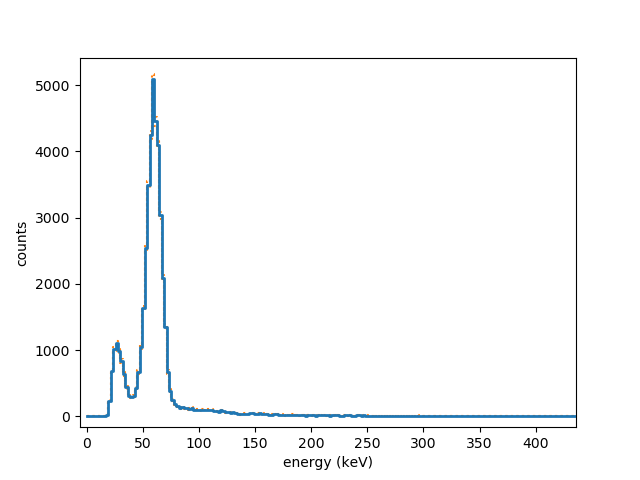Toolkit for soundcard gamma ray spectroscopy
Project description
Python toolkit for soundcard gamma spectroscopy.

Spectrum of Am-241 acquired with a CsI(Tl) scintillation detector and Gamma Lab.
Introduction
This package is a Python package for the acquisition and analysis of soundcard data, specifically for gamma spectroscopy kits that use a soundcard as their ADC interface. It consists of independent building blocks (“services”) that can be connected and reconfigured to form different analysis pipelines. Examples of this are included in the repository in the examples directory.
Prerequisites
You need at least:
Python 3.6 or later,
numpy
matplotlib
the Python sound interface SoundCard
and recommended is:
scipy
Installation
Easiest is to use pip:
pip install GammaLab
Usage
Two example ready made example applications are included in a pip install.
The program `gammalab-monitor.py` lets you directly inspect the data coming from the soundcard (e.g. to confirm you indeed use the right sound interface or the manually fine tune the volume gain). Also it lets you record a data stream for later analysis with `gammalab-histogram.py --raw_ouput_file <outfile>`.
To get usage info:
> gammalab-monitor.py --help
For example:
> gammalab-monitor.py --list_input_devices
will list the available soundcard devices for data acquisition.
Another program, `gammalab-histogram.py` program acquires data, provides counts and optionally plots a gamma spectrum. Again, you can get help:
> gammalab-histogram.py --help
This provides only a limited preview of the possibilities that the Gamma Lab offers. You can compose your own applications, examples of this are in the examples directory.
More details
The applications consist of components “services” that are connected with “wires.” For a component to be included it needs to be imported and instantiated, for example you almost always need:
from gammalab.acquisition import Soundcard soundcard=Soundcard()
After instantiating additional components, say:
from gammalab.backend import SaveRaw save=SaveRaw()
they need to be “wired”:
soundcard.plugs_into(save)
At the moment, components can have one input and one output, but an output can be connected to multiple components. When all components are wired, you start the pipeline:
main(timout=100)
The time-out is optional. The application will run until <enter> is pressed or until the time-out reached.
The following services are available:
from gammalab.acquisition import SoundCard from gammalab.acquisition import Noise from gammalab.transform import Raw2Float from gammalab.transform import DownSampleMaxed from gammalab.transform import Identity from gammalab.analysis import PulseDetection from gammalab.analysis import Histogram from gammalab.analysis import Count from gammalab.backend import SoundCardPlay from gammalab.backend import Monitor from gammalab.backend import SaveRaw
Note that most of these provide rudementary implementations and are open to improvement, though the code is somewhat conceptual in nature and probably will never be the most optimized.
Development
It is not difficult to program additional services.
A service is a class with at least the methods: start stop and close. A service which accepts input should instantiate a “wire” class defining its input and have connect_input and receive_input methods (normally taken care of by deriving from ReceivingService class). If it generates output, the service should have an output_protocol method, which checks the input wire format and propagates any additional information to the wire. It also needs to have some methods normally implemented by deriving from the SourceService class (notably the `plugs_into` method).
Services start up a seperate multiprocessing thread to do their computations. The simplest example of a service with input and output is the following:
class Identity(ThreadService, SourceService, ReceivingService):
input_wire_class=RawWire
output_wire_class=RawWire
def output_protocol(self, wire):
super().output_protocol(wire)
wire.CHANNELS=self.input_wire.CHANNELS
wire.RATE=self.input_wire.RATE
wire.FORMAT=self.input_wire.FORMAT
def process(self, data):
return data
This service just forwards the input data (a dict containing a key data with the raw byte stream) to its output, retaining its sample rate, format and number of channels.In this case the necessary start etc methods are provided by inheritance from ThreadService. The process method defines the actual processing done.
Project details
Release history Release notifications | RSS feed
Download files
Download the file for your platform. If you're not sure which to choose, learn more about installing packages.











